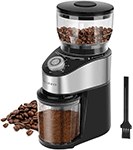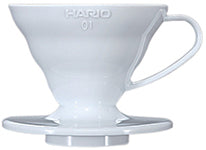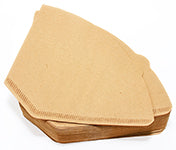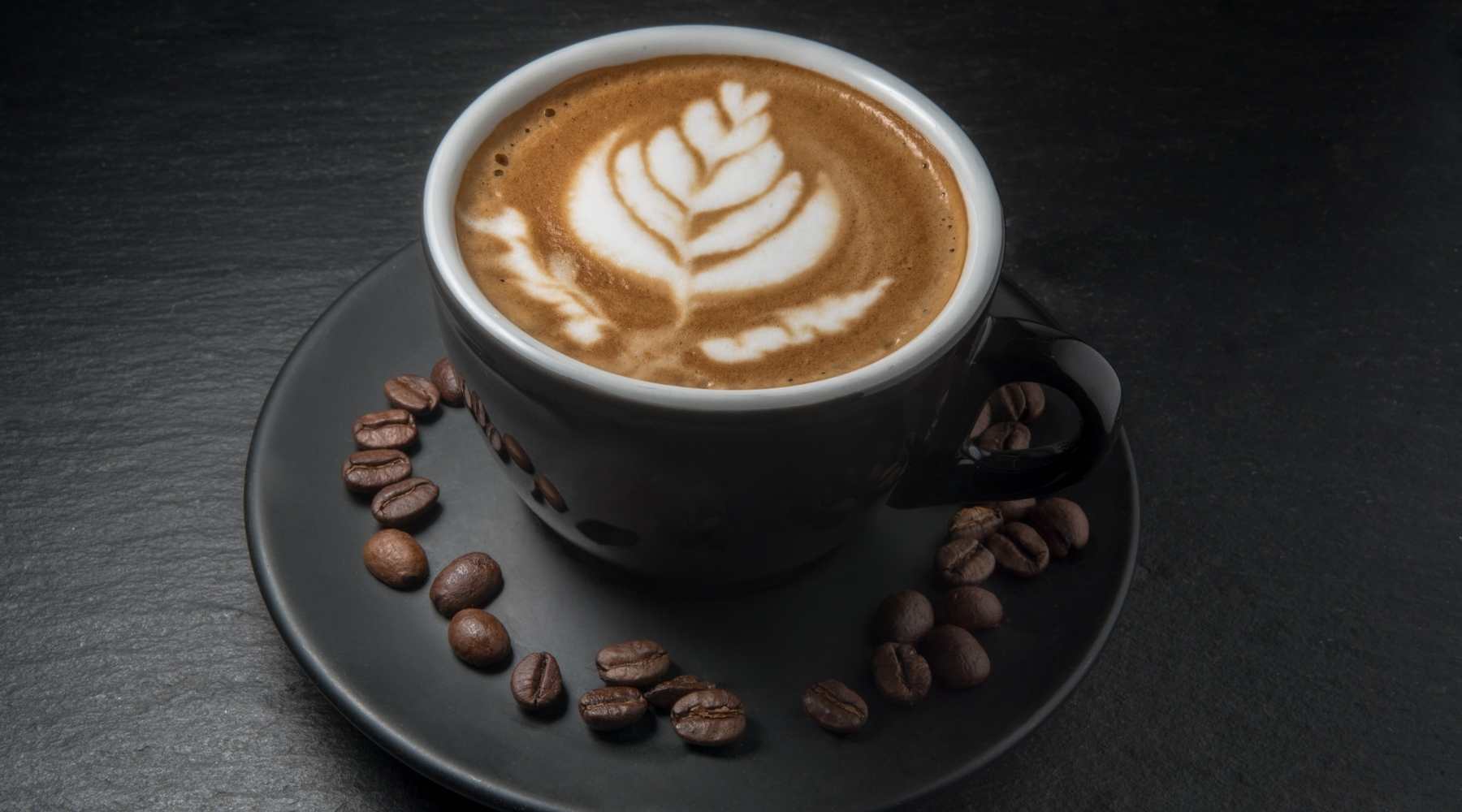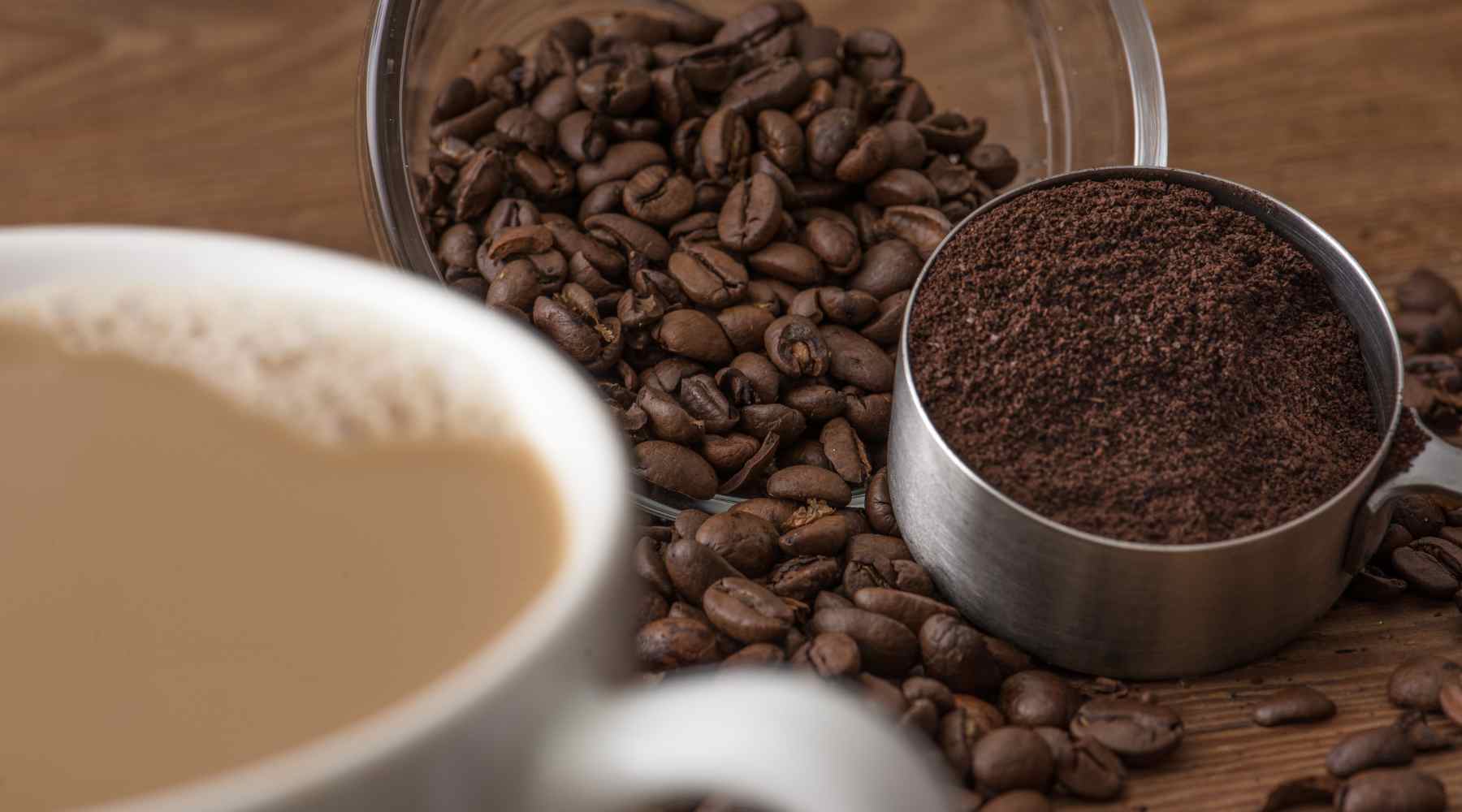How to make Pour-over coffee - Brew Guide
What is Pour-over coffee?
What You’ll Need
We use 16 grams of water per 1 gram of coffee. Our recipe makes 500 grams (ml); approximately 17 ounces of brewed coffee but you can adjust your coffee to water ratio according to your personal taste.
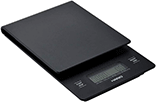
Scale
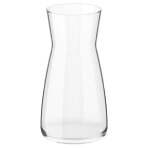
Carafe to brew into

Hot water (195–205 F)
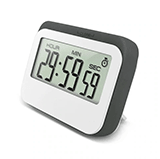
Timer
Recommended Coffees
How to brew pour-over coffee
Brew Time
8-10 minutes
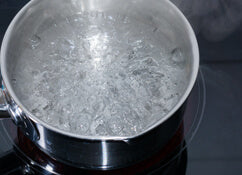
Step 1:
Bring 500 grams (ml) of water to a boil and let cool
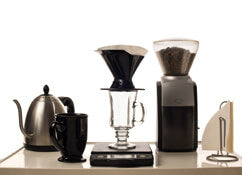
Step 2:
Crease edges of paper filter in opposite directions to ensure fit, then place the filter in the dripper
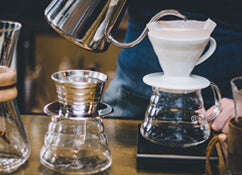
Step 3:
Rinse paper filter (to avoid paper taste) and discard the water used for rinsing
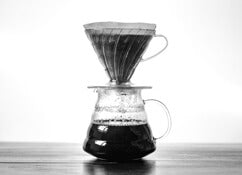
Step 4:
Place dripper on top of the carafe or serving container

Step 5:
Weigh and grind coffee (grind to medium-fine or roughly the size of granulated table salt)
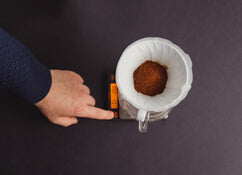
Step 6:
Add ground coffee to filter; make sure the coffee bed is level
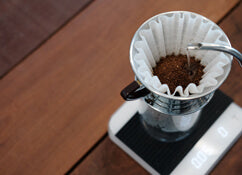
Step 7:
Add 60g of water to "bloom" grounds. Start the timer and gently saturate the grounds with hot water, pouring in a circular pattern within 10s; stop before coffee starts to flow from the bottom of the filter.
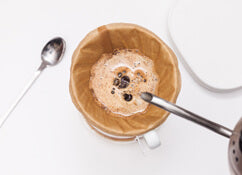
Step 8:
Stir the surface of the slurry or Swirl the dripper 3 times, Wait 30–45 seconds
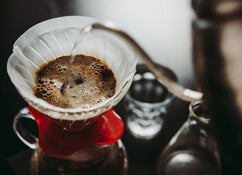
Step 9:
Slowly pour 220g of water at 0:45 min

Step 10:
At 1:30 Slowly pour the remaining water

Step 11:
Gentle swirl 3x when the water level is ½ way
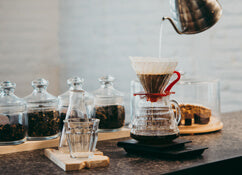
Step 12:
Keep the liquid level in the dripper between ½ and ¾ full. Avoid pouring along the edges of the coffee bed. Control brewing time and liquid level by slowing or speeding up the pour as needed; total brew time should be 3–4 minutes.
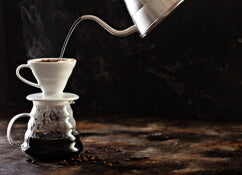
Step 13:
Serve and enjoy!
Pour over coffee vs drip coffee
For pour-over coffee, you'll need a pour-over brewer and filter. You can use pour-over brewers like the Hario V60 or Chemex for your pour-over coffee brewing. Drip coffee is made by pouring boiling water through ground coffee that's inside of a filter (most often paper). Using drip coffeemakers like Keurig machines, you make single servings of drip coffee quickly and easily!
While pour-over and drip batch coffee share a few aspects, pour-over coffee is much more complex and nuanced than drip coffee. That said, if you're used to automatic drip coffee, it's very likely you'll enjoy pour-over even more as it produces a more delicate and elaborate flavour.
The pour-over process allows you to experiment with different variables like grind size, water temperature and pour rate (the speed at which your pour the hot water over the ground beans). You can control these variables in order to make a pour-over coffee that tastes how you want it! It might take some time before you get used to making pour-over coffee well, but once you've got it down, we're sure that this will quickly become one of your favourite brew methods.
Pour over coffee vs french press
In pour-over coffee, you pour hot water over a bed of ground beans in order to extract flavour. In the French press, the grounds and water are stirred together before being left to steep for some time (usually around three minutes). After this amount of time has passed, the filter is pressed down which separates your brewed coffee from the grinds.
French press offers more body than pour-over because French presses use a metal filter instead of a paper filter. This allows for more oils and micro fines to pass through causing the heavier body. Also, French press has a higher extraction yield or strength as it is an immersion method.
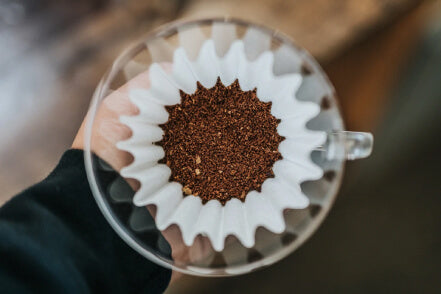
What is the best pour-over coffee maker?
There are many pour-over coffee makers on the market, but they all serve the same purpose. Some come with a few more bells and whistles than others, but there's no need to buy an expensive brewer if you're just getting started.
A pour-over is essentially a cone filter holder that allows hot water to pass through ground beans in order to extract flavour from them. This process creates a delicate cup of pour over coffee that highlights all of the coffee's nuances - it's also the favourite brewing method in coffee competitions!
The Hario V60 is a very popular pour-over coffee maker that offers a pour rate of one to two tablespoons per second. This brewer is available in many colours and can be used for other things like brewing tea! You'll need a pour-over filter as well, but you should already have this if you're making pour over.
If the Hario V60 isn't your thing, we also recommend checking out the Chemex which has been around since 1941 - it's now back on the market with updated materials and designs after being discontinued for some time! The Chemex is another great choice because its hourglass shape allows for even extraction through special filters made just for it.
What is the pour-over coffee ratio?
How many grams of coffee for pour over
The coffee to water ratio is ultimately a personal choice. Some people like it stronger while some people prefer lighter notes. The best way to find how many grams of coffee for pour over works for you is to start with a recipe and make adjustments from there.
We recommend a starting point of 16 grams of water for each gram of coffee when brewing pour over. To help you find the right amount for your cup size, we've put together a quick chart.
The pour-over coffee ratio is how much ground coffee you use for a certain amount of water. This is the recipe we recommend: 1g of ground coffee for every 16 to 17g (ml) of water.
For example, if you're used to brewing large batches of coffee such as 500ml, you'd use 30g of ground coffee. If you're brewing directly into an 8oz cup you can use 14g.
If you don't have scales to weigh your beans and water, just remember this simple formula: three tablespoons per 8oz (240ml) cup! A standard pour over brewer like the Hario V60 will make one serving at a time - in case you want more than that, try making in batches or using larger brewers like Chemex which can handle up to four servings at once!
Pour-over coffee ratio chart
| Coffee cup size | Water in gra ms (ml) | Ground coffee in grams |
|---|---|---|
| 4oz (120ml) | 120g | 7.5g |
| 6oz (177ml) | 177g | 11g |
| 8oz (236ml) | 236g | 15g |
| 12oz (354ml) | 354g | 22g |
| 14oz (414ml) | 414g | 26g |
| 17oz (500ml) | 500g | 31g |
What is the best pour-over coffee filter?
There are pour-over coffee filters that fit into almost any brewer on the market, but we recommend using the Hario V60 pour-over paper filter for pour over coffee because it allows for the most even extraction.
Paper pour-over filters are disposable and will need to be replaced after each use. They are the preferred choice because they don't affect the flavour of pour over coffee and because they brew a very clean cup.
If you want a reusable pour-over filter that won't let any oil or particles out while still allowing liquid to flow through it effortlessly, go with metal mesh. These are great because they don't need to be replaced after each use as disposable pour-overs do!

What is the best pour-over kettle?
When brewing pour-over coffee you'll need a pour-over kettle that has an easy pour spout and precise pour control. While any recipient that allows you to boil water could work, most enthusiasts of pour over coffee advocate for gooseneck keetles. This type of kettle has a long spout that allows you to pour the water exactly where and when you need it.
The Hario V60 pour-over coffee kettle is an excellent choice because it's inexpensive, easy to use and will let you control pouring with precision! The gooseneck design makes sure your pour isn't too fast or slow - just right for brewing pour over coffee.
What’s the perfect pour-over grind size?
The pour-over method requires a medium to coarse grind, which is the same as for drip coffee. You can use pre ground pour over beans or you can do it yourself! Either way, pay attention to the coffee grind size as the slightest adjustment can make your cup of coffee go from good to great.
If you want to make sure your pour over coffee comes out just right every time, we recommend investing in an electric burr grinder that will let you control how fine and course your pour over coffee is ground - this way the flavours of each individual bean won't be lost after brewing!
How to bloom coffee pour over?
Blooming pour over coffee is a step that most pour-over brewers can't afford to skip. This process allows for the best extraction of flavours by making sure you let your ground beans steep in water before actually pouring it onto them - this way, all the different compounds contained within will come out at their full potential without any loss or alteration!
Blooming is important because of the coffee degassing process - if you pour hot water directly onto coffee ground, it will release carbon dioxide and result in a more balanced, less bitter cup.
To bloom your pour-over beans, simply pour hot water into the coffee bed before you pour the rest of your water. You'll see some bubbles making their way to the surface, these are the CO bubbles that need to be released before you pour in the rest of your water.
Brewing pour-over coffee doesn't require a lot of fancy equipment and it's easy to make! If you love pour-over coffee and want to enjoy delicious coffee at home, shop our selection of pour-over coffee beans

 ALL
ALL

